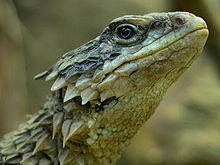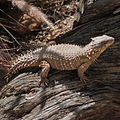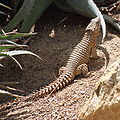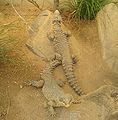- Giant Girdled Lizard
-
Giant Girdled Lizard 
Conservation status Scientific classification Kingdom: Animalia Phylum: Chordata Class: Reptilia Order: Squamata Family: Cordylidae Genus: Cordylus Species: C. giganteus Binomial name Cordylus giganteus
Smith, 1844Cordylus giganteus, the Sungazer, Giant Spiny-tailed Lizard, Giant Zonure, or Giant Girdled Lizard is the largest species of Girdled Lizard. They live in colonies and dig burrows into the silty soil of the Themeda grassland in South Africa. The name Sungazer comes from their habit of sitting at the burrow entrance and facing the sun. They are insectivores, but occasionally will eat small vertebrates. Sungazers reproduce every other year, and only produce one or two offspring. The decline in numbers is a result of habitat destruction (conversion of the grassland to farmland) and illegal collecting for the great pet trade.
Sungazers are protected by spiny dorsal scales and large spines run along the back of the head. The tail is armed by whorls of large spines and is waved at predators that pursue it into a burrow. Adults are 150-180 mm from the snout to the vent. The back is yellow to dark brown and the sides are yellow. Males can be identified by the presence of enlarged scales on the forearm.
Captive bred Sungazers, usually juveniles, are occasionally imported from South Africa to the U. S. and command a very high price. They are long-lived, hardy captives, but rarely reproduce in captivity. Cordylus tropidosternum and Cordylus jonesii are occasionally marketed as “Dwarf Sungazers.”
Gallery
-
Cordylus giganteus at the San Diego Zoo
-
Cordylus giganteus at the San Diego Zoo
-
Three Giant Girdled Lizards in Tierpark Hagenbeck Zoo
References
- World Conservation Monitoring Centre 1996. Cordylus giganteus. 2006 IUCN Red List of Threatened Species. Downloaded on 28 July 2007.
Branch, B., 1998. Field Guide to Snakes and other Reptiles of Southern Africa: Ralph Curtis Books Publishing, Sanibel Island, Florida, 399 p.
Fitzsimons, V. F., 1943. The Lizards of South Africa: Transvaal Museum Memoir, Pretoria.
Extant Cordylidae species Chamaesaura Cordylus PlatysaurusBroadley's Flat Lizard (P. broadleyi) · Cape Flat Lizard (P. capensis) · Common Flat Lizard (P. intermedius) · Dwarf Flat Lizard (P. guttatus) · Emperor Flat Lizard (P. imperator) · Lebombo Flat Lizard (P. lebomboensis) · Mitchell's Flat Lizard (P. mitchchelli) · Ocellated Flat Lizard (P. ocellatus) · Orange throated Flat Lizard (P. monotropis) · Pungwe Flat Lizard (P. pungweensis) · Sekukhune Flat Lizard (P. orientalis) · Soutpansberg Flat Lizard (P. relictus) · Spotted Flat Lizard (P. maculatus) · Striped Flat Lizard (P. torquatus) · Waterberg Flat Lizard (P. minor)Pseudocordylus Lang's Crag Lizard (P. langi) · Prickly Girdled Lizard (P. spinosus) · P. capensis · Categories:- IUCN Red List vulnerable species
- Cordylus
- Reptiles of South Africa
- Pet lizards
Wikimedia Foundation. 2010.
Look at other dictionaries:
Cordylus — Tropical Girdled Lizard Cordylus tropidosternum Scientific classification Kingdom … Wikipedia
List of Kamen Rider Decade characters in the New Worlds — The characters of Kamen Rider Decade exist amongst various different iterations of reality within the series referred to as an A.R. World (Another Rider s/Alternate Reality World). The New Worlds (新たな世界, Aratana Sekai?) are the A.R. Worlds that… … Wikipedia
List of reptiles of Western Australia — This is a list of reptiles of Western Australia:Crocodylia (Crocodiles);Crocodylidae * Crocodylus johnstoni (Freshwater Crocodile) * Crocodylus porosus (Estuarine Crocodile, Salt Water Crocodile)Testudines (Turtles);Chelidae * Chelodina kuchlingi … Wikipedia
-






